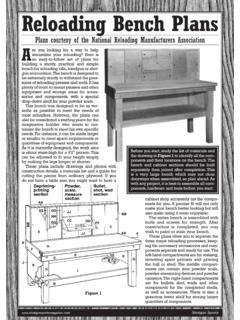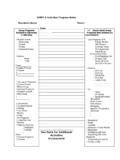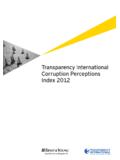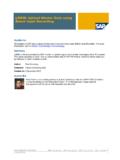Transcription of HP01 Gas turbine fuel nozzle re - Fern Engineering
1 One principal cause of damage to gas turbine hot-sectioncomponents is imbalanced fuel distribution due to dirtyor defective fuel nozzles. Having more fuel flowing toone nozzle and less to another will also cause more NOxand COemissions because hot and cold spots are simultaneously existingin the combustion section. Those same hot spots reduce creeplife of the combustion liners, transition pieces, and turbine nozzlesand blades. Luckily, these problems can be minimized by carefulrefurbishment and calibration of the fuel nozzles. fuel nozzle malfunctions. Gas turbines typically have mul-tiple fuel nozzles through which fuel is injected into the combus-tion zone (Fig. 1). Ideally, fuel flowrate through each nozzle shouldbe uniform and mixing of fuel with air should be equally effectivefor each nozzle . If liquid fuel is being injected, atomization of thefuel droplets should also be identical for each , flow maldistributions can often occur among thedifferent fuel nozzles in a turbine .
2 Causes of nonuniform flowscan include: Manufacturing defects ( , machining burrs or nicks) Improper assembly ( , leaking gaskets, mismatched parts) Changes in nozzle flow area due to erosion or coke and ashdeposits Cracks in the nozzle due to fatigue Faulty operation of check valves in fuel maldistributions occur, the result will be uneven firing tem-peratures around the combustion section circumference. Since mostgas turbines do not have thermocouples at the exit of the combus-tors, these uneven firing temperatures are typically detected by ther-mocouples mounted further downstream. Single-shaft gas turbinesusually have an array of thermocouples installed around the cir-cumference of the turbine outlet, while multiple-shaft turbines typ-ically have a thermocouple array around the power turbine all gas turbine control systems monitor exhaust tem-perature spread ( , maximum minimum) and issue an alarmwhen this reaches an OEM-specified value.
3 The challenge for theturbine operations and maintenance staff is then to figure out thesource of the high-temperature swirl is in the flow as it passes through the turbine . Con-sequently, one cannot assume that an abnormally high or lowtemperature at the 4 o clock position in the exhaust was causedby the fuel nozzle located at the 4 o clock position in the com-bustion section. It may come from the fuel nozzle at the 2 o clockor 6 o clock position, or even further turbine performance monitoring software has now devel-oped to the point that it can calculate the amount of swirl in theflow and rotate the position of the exhaust thermocouples to indi-cate the location of the fuel nozzle that produced the flow passingby each example of the graphical output fromthis type of analysis is shown in Fig. TRANSFER/ROTATING EQUIPMENTGas turbine fuel nozzlerefurbishmentFollow these guidelines to improve reliability and reduce emissionsJ. N. PHILLIPSand P.
4 SIMAS,Fern Engineering , Inc., Pocasset, MassachusettsWater manifoldconnectionsFuel nozzle bodyLiquid fuelconnectionAtomizing airconnectionWater injectionspray nozzleAtomizingair capFuel oiltransitionpieceassemblySwirl tipA typical gas turbine will have 6 to 16 of these of a combustion monitor graphical PROCESSING JANUARY 2004I1 Proof only not for spreads at the gas turbine exhaust would corre-spond to even greater temperature spreads at the combustor sec-tion outlet. If one models the turbine section as an isentropicexpansion of perfect gas, from basic thermodynamic principals itcan be shown that temperature at the turbine section inlet, Tt, isrelated to the exhaust temperature, Tx, by the following formula:where kis the ratio of specific heats, Pt/Pxis the pressure ratioacross the turbine , and the temperatures are taken as absolute val-ues. Basic algebra then dictates that the difference between max-imum and minimum temperatures at the turbine inlet, Tt max,is related to the exhaust temperature spread, Tx max, by:Using typical values of 12 for pressure ratio and for kin shows that, when the exhaust temperature spread is 50 C, maxi-mum and minimum temperatures at the turbine inlet will be 89 C.
5 Impact of combustion willcause higher emissions of either NOx(due to hot spots in thecombustion zone) or CO and unburned hydrocarbons (due tocold spots and poor mixing or atomization).If too much fuel is injected through one or more fuel nozzles,the combustion gases exiting from that region will be hotter thanthe average. This will reduce life of the hot section parts that areexposed to the hotter life of metal components in the hot section of a gas tur-bine is extremely sensitive to metal temperature. Fig. 3 shows therelationship between metal temperature and creep life of severalmaterials typically used in gas turbine hot sections. Note that atemperature increase of only 50 C will reduce the materials life byan order of consequences of hot-section component failures causedby overheating can be quite costly. In extreme cases, combustionliner failures can allow hot flames to impinge on the turbine pres-sure casing, which can lead to catastrophic engine failure.
6 Evenbefore casing failures occur, broken pieces of the liner can passinto the expander section and cause extensive blade maldistribution to rapid degradationof hot-section parts life that can take place, corrective action shouldalways be taken whenever high exhaust temperature spreads areencountered. While there can be other causes of the high spreads(see below), the most logical place to start is the fuel nozzles. When a set of fuel nozzles is removed for testing and refur-bishment, it should be put through a multistep process called forin OEM maintenance protocols. During the process, each nozzleis disassembled, cleaned and inspected. Any worn-out parts arerepaired or replaced, and the nozzles are rebuilt, flow tested and cal-ibrated to ensure uniform flow. Typical before and after pho-tos of refurbished fuel nozzles are shown in Fig. 4. A key step in theprocess is the inspection, which can help in the problem diagno-sis. For example, many combustion problems can be diagnosedby examining the wear patterns on the nozzles.
7 The flow tests are conducted with an apparatus that supplies theliquid or gas fuel , and atomizing air and NOxsuppression waterif applicable, to the nozzle at the OEM-specified conditions. Basedon the flow versus pressure results of each nozzle , adjustments aremade in the flow path geometry to ensure uniform flow at similarconditions. Typically, a set of nozzles can be tuned to provide nomore than 3% deviation in flow among the nozzles. Since temperature increase across a gas turbine combustor canbe on the order of 800 C (1,440 F), a 3% difference in fuel flowshould result in a firing temperature spread on the order of 24 C(43 F). This is within typical OEM guidelines; however, based on theearlier discussion of the impact of metal temperature on creep life, evensmaller spreads could yield a significant improvement in parts addition to the flow tests, the nozzle spray patterns shouldbe checked for irregularities, and the nozzle body should be pres-sure tested to check for leaks and to verify proper gasket , the check valves in the fuel lines leading to the nozzlesshould be cleaned, inspected and pressure tested to ensure leak-free West Coast refinery was experiencing excessivetemperature spreads in the exhaust of its gas turbines.
8 It sent theirfuel nozzles to a lab for testing and refurbishment. Upon receipt,each nozzle was flow tested to confirm whether the nozzles wereproviding uniform flow. As shown in Fig. 5, the flow dischargecoefficients, Cd, of the nozzles an indication of the flow deliv-ered for a given supply pressure deviated by almost 6%. Aftercleaning and refurbishing the flow passages, the deviation in Cd TTPPt maxt maxtxkk = 12()TTPP txtxkk= 11()2 IJANUARY 2004 HYDROCARBON PROCESSINGHEAT TRANSFER/ROTATING EQUIPMENTC reep life of GT materials under 579 MPa stress6006507007508008509001001,00010,00 0100,000 Time to rupture, hrMetal temperature, CRene N5 Rene 125 Rene 80 Creep life of metal components is extremely sensitive tometal disassembled fuel nozzle before (left) and after (right) less than 2%. Once the reworked fuel nozzles were reinstalledin the gas turbine , the temperature spread was reduced to 22 C(40 F) versus an average of 72 C (130 F) before cause and effect were obviously causes of high exhaust temperature other sources of high-temperature spreads can be the com-bustion liner and the first-stage turbine nozzles.
9 The metal liner ofthe combustion zone is carefully designed to allow a specificamount of air into the flame zone and then an additional amountin the dilution zone. Air flow to each zone is determined by the sizeand number of holes in the liner. As the liners wear, cracks canoccur and eventually produce new paths for the air flow, which willdistort the combustion third potential source of nonuniform fuel /air ratios is nonuni-form flow areas downstream of the combustion zone. During nor-mal operation, flow through the turbine section first-stage nozzlesis choked. To ensure uniform flow through each combustor upstreamof the first-stage nozzles, the cross-section flow area at the nozzle throat should be identical. However, nonuniformities can occurdue to manufacturing defects, nozzle erosion or fouling nozzles. HPLITERATURE CITED1 Phillips, J. N., P. Levine and S. Tustain, Performance Monitoring of GasTurbines, Proceedings of COMADEN 2000 Conference, Houston,December , R.
10 E., D. A. Sullivan and F. Abegg, Performance Monitoring of GasTurbines for Failure Prevention, ASME Technical Paper 92-GT-267, PROCESSING JANUARY 2004I3 HEAT TRANSFER/ROTATING EQUIPMENTJ effrey N. Phillipsis vice president of Fern Engineering , holds a BA in mathematics from Austin College, a BS in mechan-ical Engineering from Washington University, and MS and PhDdegrees in mechanical Engineering from Stanford University. Dr. Phillips industrialexperience has focused on analyzing gas turbine and combined cycle power plant per-formance. He has particular interest in use of nonconventional fuels in gas to joining Fern, he worked for the Royal Dutch/Shell Group on developing acoal gasification Simasis the manager of fuel nozzle refurbishment forFern Engineering , Inc. He has over 20 years of experience in fuel noz-zle testing, refurbishment and design. Recent projects have includedthe fuel nozzle design for landfill gas and development of a device that converts a GEdual- fuel nozzle to gas-only use and eliminates need for purge air while also allow-ing the nozzle to be easily restored to dual- fuel nozzle numberCd - coefficient of dischargeMax.






